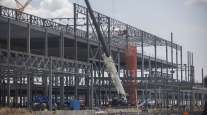Manufacturing Cooled in July Following Five-Month High

Manufacturing in the United States cooled in July from the highest level in five months, a sign of fitful progress in the industry.
The Institute for Supply Management’s index fell to 52.7 from a June reading of 53.5 that was the fastest since the start of the year, a report from the Tempe, Arizona-based group showed Monday. Readings greater than 50 indicate expansion. The group’s employment measure declined from a month earlier, and order backlogs slumped.
A pickup in the ISM’s orders index to a seven-month high and increased production indicate steady consumer spending is underpinning activity at American factories. Without stronger overseas markets and a rebound in business investment, acceleration in manufacturing may prove difficult to achieve.
“Manufacturing will show some improvement in the second half, but it’ll be very slow,” David Sloan, a senior economist at 4Cast Inc. in New York, said before the report. “We’re optimistic about the U.S. economic outlook, but the exports picture is a bit worrying. Energy is going to be less of a drag.”
The median forecast in a Bloomberg News survey of 75 economists was 53.5. Estimates ranged from 52 to 54.5.
The ISM group’s new orders gauge climbed to 56.5 from 56 the prior month, and a measure of production rose to 56 from 54. The index for orders waiting to be filled decreased to 42.5, the weakest since November 2012, from 47.
The employment index declined to 52.7 from 55.5. The measure of export orders fell to 48 from 49.5. The gauge of factory inventories dropped to 49.5 from 53, and customer stockpiles decreased to 44 from 48.5.
The report also showed the index of prices paid dropped to 44 from 49.5.
Eleven of 18 industries surveyed by the purchasing managers’ group posted growth, led by textile mills, paper products and apparel and leather.
The figures are in sync with a gradually improving economy. Gross domestic product grew at a 2.3% annualized rate in the second quarter, after a revised 0.6% advance in the prior three months that wiped out a previously reported drop, according to Commerce Department data released last week.
Consumer spending climbed 2.9%, while investment outside of residential real estate fell at a 0.6% rate, the worst performance since the third quarter of 2012, the GDP figures also showed last week.
Other recent reports indicated business investment is starting to stabilize. American factories received more orders for capital goods such as machinery and fabricated metals in June.
Automobile demand remains a source of strength. June sales of cars and light trucks capped the strongest quarter since 2005, according to figures from Ward’s Automotive Group. The industrywide tally for July will be available later on Monday.
The advance in the dollar since mid-2014 has taken a toll on exports. The greenback remains elevated in part as investors project the Federal Reserve is on track to raise interest rates by year-end.
Industrial companies such as Caterpillar Inc. and 3M Co. are hurting because of weak global markets and the U.S. currency’s appreciation, even as the woes of the oil sector dissipate.




